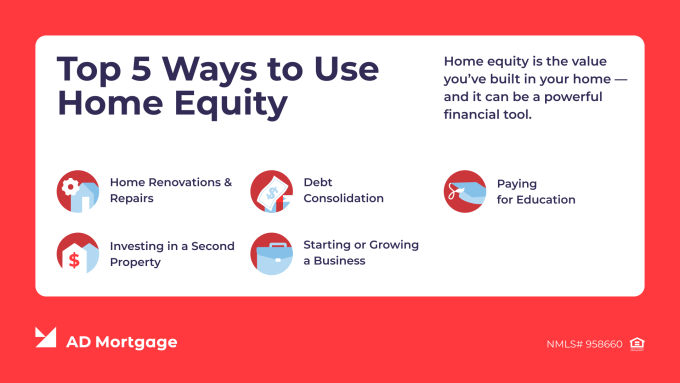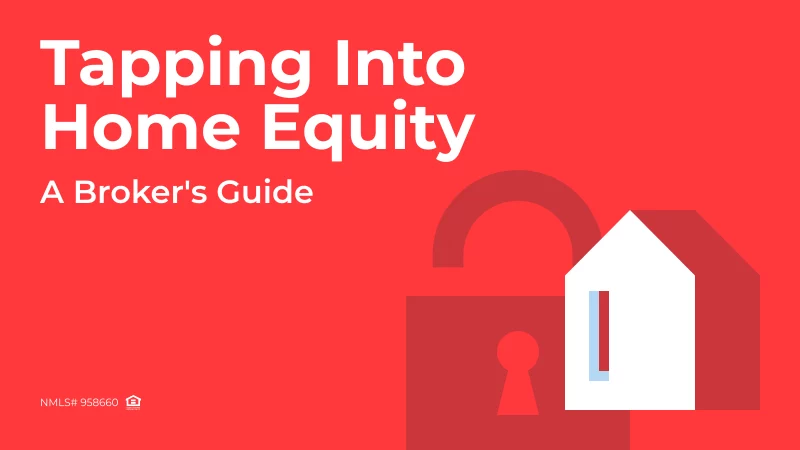To be a broker is a challenge, as you have to catch up with the fast-paced real estate market and have the latest updates to serve your clients and help them meet their financial objectives. Here is where home equity might be especially interesting.
Read on and will guide you on how to leverage home equity. You will learn about strategies that include HELOCs, second mortgages, cash-out refinancing, pros and cons of using home equity, and tips and advice you can suggest helping your clients with solutions to unlock the potential of their property to the greatest extent.
What Is Home Equity?
Home equity is the part of the borrower’s home that they own. It can be a powerful financial tool that they can use to pay off debt, renovate their house, or make other investments.
It is the difference between the amount they owe on a mortgage and the property’s price. The amount of equity in a house usually grows over time as they make payments, and thus the property value increases.
Home equity is an asset that they can borrow against to meet important financial needs such as paying off high-cost debt or paying college tuition. Read on to learn more about how home equity works, how to calculate it, and how they can use it.
How to Calculate Home Equity
Equity is the difference between what a home is worth and what is owed on a mortgage loan.
To calculate home equity, first you need to get an estimate of the home’s value by researching the value of homes like your client’s one in their neighborhood that have recently sold. Let’s assume that figure is $450,000 and the borrower’s loan, which they can get from their mortgage statement, is $100,000. Here’s how to calculate the home equity in this case scenario:
Equity = Value of home – loan balance
Equity = $450,000 – $100,000
Equity = $350,000
How to Build Home Equity
What can a borrower do to build home equity? Here are some easy ways to do that.
1. Make a Larger Down Payment
A down payment is the first payment made toward a home’s total purchase cost. If a borrower makes a larger down payment, they will need to finance a lower amount of money and have more equity in their home from the very first day.
A larger down payment decreases their monthly mortgage payments and can help them qualify for a more competitive interest rate. If they can place a down payment of 20% or more of the purchase price, they can also avoid private mortgage insurance (PMI).
2. Avoid Private Mortgage Insurance
Private mortgage insurance (PMI) is a monthly payment required if a borrower has less than 20% equity in their home. PMI protects the lender if your client is unable to continue making their mortgage payments. However, PMI costs can add up over time, reducing the portion of each payment applied toward the mortgage principal. Fortunately, borrowers can take a few steps to get rid of PMI or avoid it entirely.
3. Make Payments Twice a Month
This simple strategy can considerably impact home equity. Splitting your client’s mortgage payment in half and paying it every two weeks results in 26 payments a year, which equals 13 full payments – one extra payment per year.
Thanks to this strategy, the amount of interest that accrues each month is reduced, and a client can build home equity faster, allowing them to pay off the loan earlier.
4. Raise Monthly Payments
When your client pays more than the minimum amount required by the mortgage lender, the extra money reduces the principal balance on their mortgage.
By paying the principal ahead of schedule, they can reduce interest costs, build home equity, and pay off their mortgage faster.
Lowering the principal means accruing less interest over the life of the loan, thus paying off their loan sooner. This can end up with substantial gains in equity, allowing borrowers to have more convenient financing terms for equity-based products like home equity lines of credit (HELOCs).
5. Refinance to a Shorter Loan Term
Refinancing from a 30-year mortgage to a 15-year term will increase their monthly mortgage payments. However, it will also lower the interest a borrower will pay over the life of the loan. As a result, their payments will go toward building equity in their home and paying the principal faster rather than applying against interest. Refinancing to a shorter loan term means borrowers own their home outright much sooner, giving them greater financial flexibility and stability.
Before following this strategy, consider your client’s monthly budget and work with a trusted mortgage professional to estimate if refinancing to a shorter term is right for their financial situation and goals.
6. Enhance Home’s Value
Another wise investment is to upgrade the house and make it a more comfortable and valuable place. What improvements should your clients make?
Here are popular ways to increase the value of their home:
- Make necessary repairs
- Add a bathroom or bedroom
- Renovate the kitchen
- Install new flooring
- Paint walls
- Replace windows and doors
- Install energy-efficient features
Don’t forget to correct invalid information about the property on the county’s tax rolls.
7. Wait for the Home’s Market Value to Increase
It’s impossible to predict the housing market, but in general – the longer a borrower can wait, the better. Overall, the value of homes tend to trend upward unless there is a serious economic downturn.
By waiting for their home’s market value to increase, they might be able to maximize their property’s equity.
8. Avoid a Cash-Out Refinance
A cash-out refinance allows your clients to borrow money by leveraging their home equity. Be attentive to it, as it’s rather tricky. Taking a cash-out refinance reduces the equity they have in their home. It also can make it harder to sell a borrower’s house and limit their future financing opportunities.
To build home equity, it is better to avoid any unnecessary loans or cash-out refinancing. Instead, it’s better to focus on depositing regular payments of the principal on your client’s mortgage.
Ways to Use Home Equity
There are very few restrictions on how home equity can be used. That said, here are some of the most common ways.
1. Investing in a Second Property
A borrower can also use equity to buy an investment property – a residence they’re going to flip or rent out for income.
The biggest benefit is that if they’ve built up a lot of equity, a home equity loan or HELOC lets them access a large amount of money. That’s important when buying investment properties, which have stricter eligibility criteria than second homes and typically require a 15-25% down payment.
At the same time, there are risks involved in using equity to finance an investment property. Ideally, your client’s new property will generate consistent income (via rent or leases) to help them repay their home equity loan or HELOC on time. Unfortunately, that’s not guaranteed.
2. Home Renovations & Repairs
Do your clients want to renovate their home but don’t have cash on hand? They can pay for home improvements by taking out a home equity loan. When they finance their renovations using the equity, they’ll be paying for the renovations at a much lower interest rate than if they were paying for them with a credit card or personal loan.

3. Paying for Education
College can be expensive, and student loans aren’t always the lowest-interest way to cover tuition and room and board. Borrowers can use their home equity to get cash for tuition or to consolidate their existing student loans into a single, lower-interest loan.
4. Debt Consolidation
Mortgage refinance and home equity loan interest rates are typically much lower than interest rates for credit cards, auto loans and personal loans. If they have any of these high-interest debts, they can save big by putting their home equity to work.
There are a couple of benefits to using home equity for debt consolidation:
- Consolidating debt simplifies payments. By paying off bills with cash from their home, borrowers will bundle their debt payments into a single, lump-sum loan.
- Saving big on interest. Interest rates for credit cards and personal loans commonly exceed 20%, while mortgage refinance and home equity loan interest rates are significantly lower.
5. Setting Up or Growing a Business
Borrowers can cover startup costs or buy necessary equipment. However, it’s important to plan budget and repayment strategy in advance, as the property works as collateral. Overall, this might be a smart way to access capital with relatively low interest rates compared to other loan types.
Second Mortgage:
Solutions for brokers!
- Up to 85% CLTV
- $500K max loan, up to 50% DTI
- No prepay penalties
Expand Your Offerings — Contact Us Today!
Discover Program
Benefits and Risks
Equity can be a great way to reduce expenses or consolidate higher-interest debt. However, it’s better to weigh the pros and cons before taking out a loan.
| Pros | Cons |
|---|
| Lower interest rates. Home equity loans, lines of credit and cash-out refinances usually have lower interest rates than credit cards and personal loans. This allows borrowers to pay less interest and save thousands of dollars. | The home might be at risk. The borrower’s home secures home equity loans, lines of credit and cash-out refinances. If they can’t make payments on time or default, they risk losing their home. |
| No restrictions on use. Borrowers can use the money to cover any expenses they consider necessary. | It may add an extra monthly payment. Unless your client is using a cash-out refinance, they will end up with two payments due every month. This can make it harder to stay on top of their finances. |
| Tax benefits. If a borrower uses the money for home repairs or improvements, they can usually deduct some or all of the interest on their taxes. | Required closing costs. Borrowers pay closing costs when they take out a home equity loan, HELOC or cash-out refinance. The closing costs may range from 3% – 6% of the loan’s principal. |
How to Choose the Right Option
When deciding how to leverage home equity, it’s important to carefully evaluate financial needs, goals, and the available options.
First, a borrower decides what they need the funds for. The purpose will determine the type of equity product that best suits it.
The most common options are a home equity loan, a home equity line of credit (HELOC), and cash-out refinancing.
- A home equity loan provides a one-time payment with fixed interest rates and payments, making it ideal for one-time expenses.
- A HELOC offers a credit line with flexible rates, suitable for ongoing or flexible spending needs.
- Cash-out refinancing is a replacement for the mortgage with a new, larger loan. A borrower takes the difference in cash, often with the benefit of lower interest rates on their entire mortgage.
Next, a borrower should assess their financial situation: their credit score, income stability, and existing mortgage terms. Some options require good credit and may have closing costs or fees.
Finally, compare interest rates, repayment terms, and fees.
Top 8 Tips and Expert Advice
1. Assess Home’s Real Equity Value
Before making any decisions, get a professional appraisal to estimate your client’s home’s current market value minus their mortgage balance. Knowing the exact equity protects them from borrowing more than they can afford.
2. Set a Financial Goal
Remind your client to use their home equity for purposes that add value or improve their financial health, such as renovating their home to increase its worth or consolidate high-interest debt. Avoid using home equity for non-essential spending.
3. Find the Best Rates and Terms
Different lenders offer varying rates and fees for home equity loans or HELOCs. Compare multiple offers, paying close attention to interest rates (fixed vs. variable), repayment periods, and any closing or annual fees.
3. Be Aware of Fluctuating Interest Rates
If a borrower wants to use a HELOC, remember that rates can fluctuate. Prepare for potential increases by budgeting extra funds or considering a fixed-rate loan if stability is important to your client.
4. Avoid Over-Borrowing
Even if a borrower has a large amount of equity, it doesn’t mean they have to use it all. It’s important to take only the amount they need and have a clear repayment plan to avoid financial burden.
5. Be Cautious of Fees and Penalties
Some home equity offerings have prepayment penalties, annual fees, or other expenses. It’s important to study the documents meticulously and talk to the borrower’s lender about all possible charges before signing.
6. Maintain a Good Credit Score
A good credit profile can help your clients receive lower interest rates and better loan terms. If they pay bills, reduce their current debt, and monitor their credit regularly.
7. Consult a Financial Advisor
This is especially true if your client’s situation is complex or they’re unsure about the best strategy. It is best to reach out to a professional for advice. Advisors can help evaluate the benefits and risks related to their unique financial situation.
Conclusion
The main point is that a borrower’s property is one of their biggest assets, with equity that they can use. It can be a long-term strategy for building wealth.
The equity they build can be helpful when consolidating high-interest debts, paying for renovations, or making repairs and renovations to increase their home’s value. However, a borrower should make sure they can make the minimum monthly payments on their loan before they close.
FAQ
1. What is the difference between a HELOC and a home equity loan?
A HELOC is a revolving credit line with variable rates. The credit limit corresponds to the amount of equity a borrower has in their home. A home equity loan is a lump sum with fixed payments. Both options use their home as collateral.
2. How do I help a client calculate home equity?
To calculate home equity, you need to subtract the mortgage balance from the current home value: Home Value – Mortgage Balance = Home Equity. The remaining amount is available for equity.
3. When should a client consider a cash-out refinance?
It makes sense when they want to access equity for large expenses. This option could be useful when funding large expenses such as renovations or consolidating debt.
4. What risks should I discuss to help my clients understand?
Tapping home equity increases debt and puts the home at risk if payments aren’t met. Interest rate changes and fees can also impact affordability. Main risks include foreclosure, rising interest rates, and overborrowing.
5. Can equity be used to buy a second home?
Yes, equity can be used as a down payment or purchase of a second home. It’s a popular strategy for investment or vacation properties.
6. What’s the credit score requirement for tapping equity?
Typically, 620+, but 700+ gets better rates. Such factors as income and debt also affect eligibility.
7. Can I offer equity products through A&D Mortgage?
Cash-out refinances are available with A&D Mortgage.





